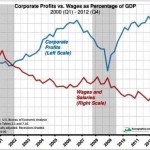A Tale of Two Cities (Both in One) Paris
Friday, March 27th, 2015
Paris is arguably the most sensually appealing city in the world, and that’s probably damning it with faint praise. Walking the streets of the Left Bank is like being treated to an afternoon massage. All the tension evaporates from one’s shoulders and neck.
Entering a restaurant — fancy or simple — puts a smile on one’s face. And enjoying the meal that has been prepared with exquisite attention to both flavor and presentation slows the pulse and lowers the blood pressure. Foie gras, steak tartar, escargot — in Paris they enhance good health rather than clog the arteries.
The pace of life in Paris is conducive to longevity, even though smoking is rampant. There seem to be far more cigarettes than cell phones. Cigarettes are the symbol of pleasure; cell phones of pressure.
Paris is art — its bridges, gardens, shops and ateliers; its architecture, designed to allow the sun to grace the sidewalks along its wide boulevards all day long. And, of course, its myriad museums — best enjoyed in small doses and unrushed. Support for the arts is manifest everywhere, paid for by a steep tax rate that doesn’t seem to ruffle French feathers.
That’s the glorious side of Paris, a cultural paradise — a heaven on earth that makes one want never to leave.
But there’s another Paris, and it’s a puzzling one, so seemingly incongruous in the atmosphere of elegance and sophistication that defines the city and makes you breathe deeply and say, “Oui, this is what life is all about.”
The other Paris is the city that says, “Non!”
“Non”, we will not serve you and your friends at the café until the last person in your party of twelve has arrived.
“Non”, you may not check your coat in the cloakroom at the museum, even though I am on duty and being paid, the museum is open and the coat closet is empty.
“Non”, you may not evict the stranger who has broken into your apartment while you were away and is now living there as a squatter. What? Isn’t one’s home sacrosanct from invaders? “Non”, not in Paris.
As a visitor, I find myself at a loss to understand this paradox. I wonder about its origin, since this attitude seems to have been a part of the city for ages. Could it date as far back as the French Revolution? Is this the way an oppressed people rose up and showed that they too could have a voice?
Interestingly, the Paris of “Non” is unaffected by the political party in power; it is neither left-wing or right-wing; it’s beyond politics.
When one discusses this puzzling anomaly with Parisian friends, they simply shake their heads and groan. They too experience it; it’s not reserved for foreigners.
Fortunately, experiencing the elegance and sophistication of the Paris of “Oui” is such a delight that the Paris of “Non” acts like a mere footnote. As it should be.

 (0 new)
(0 new)